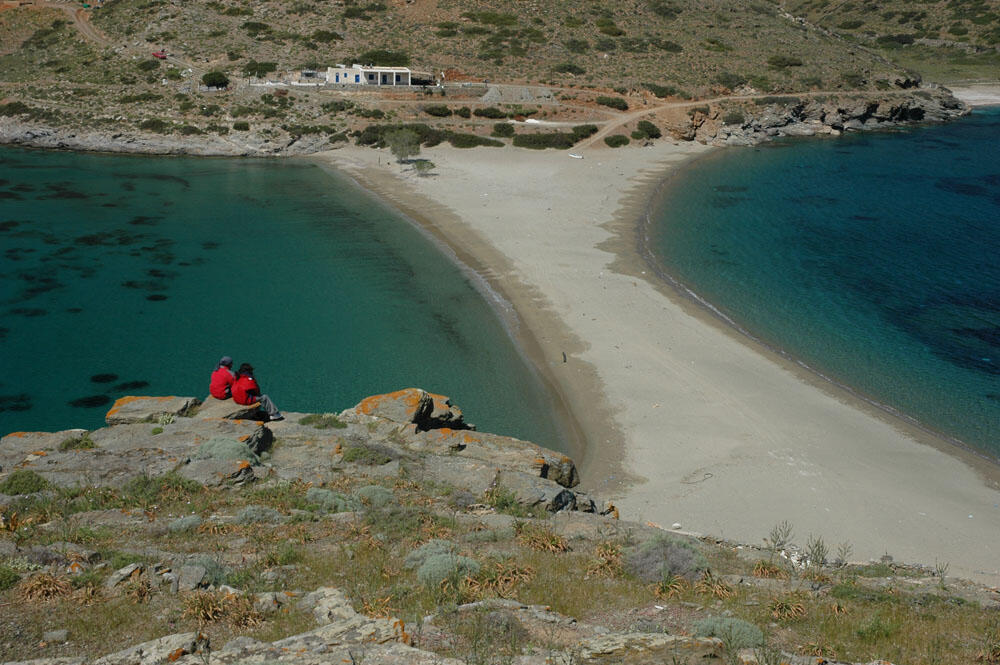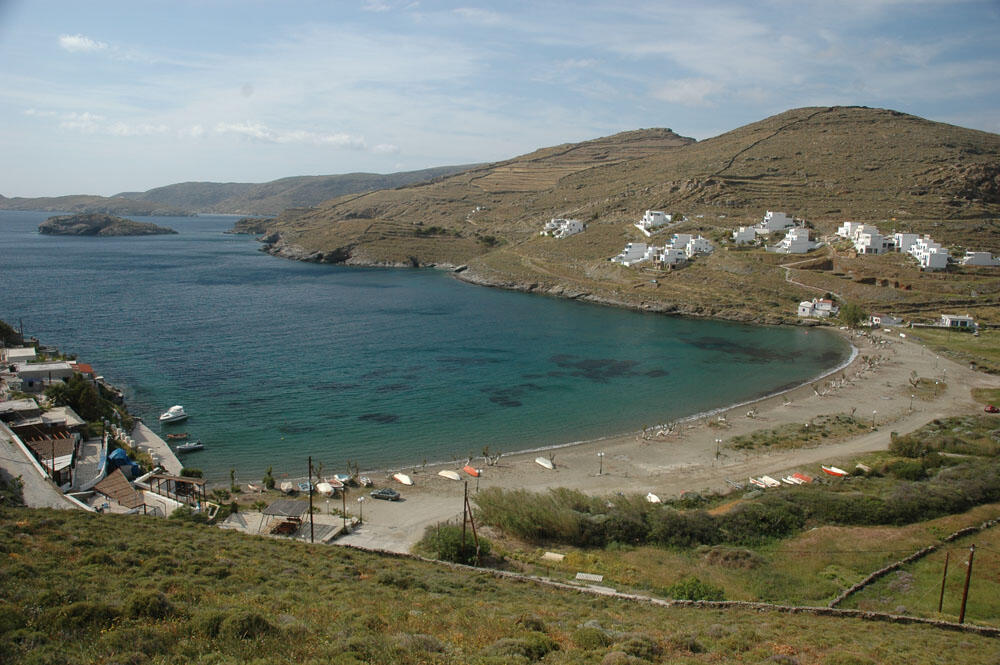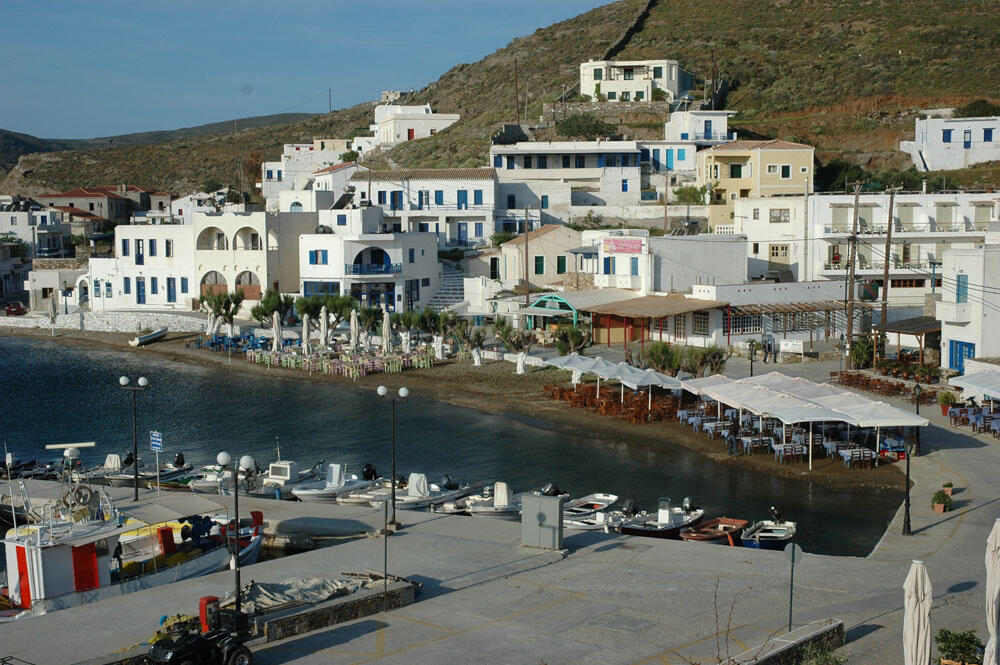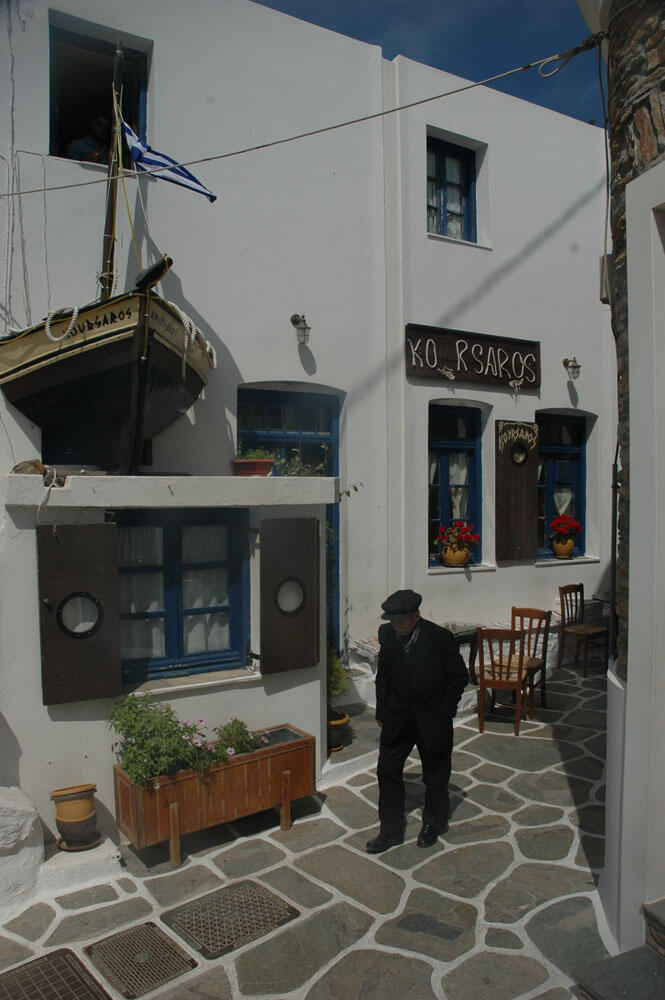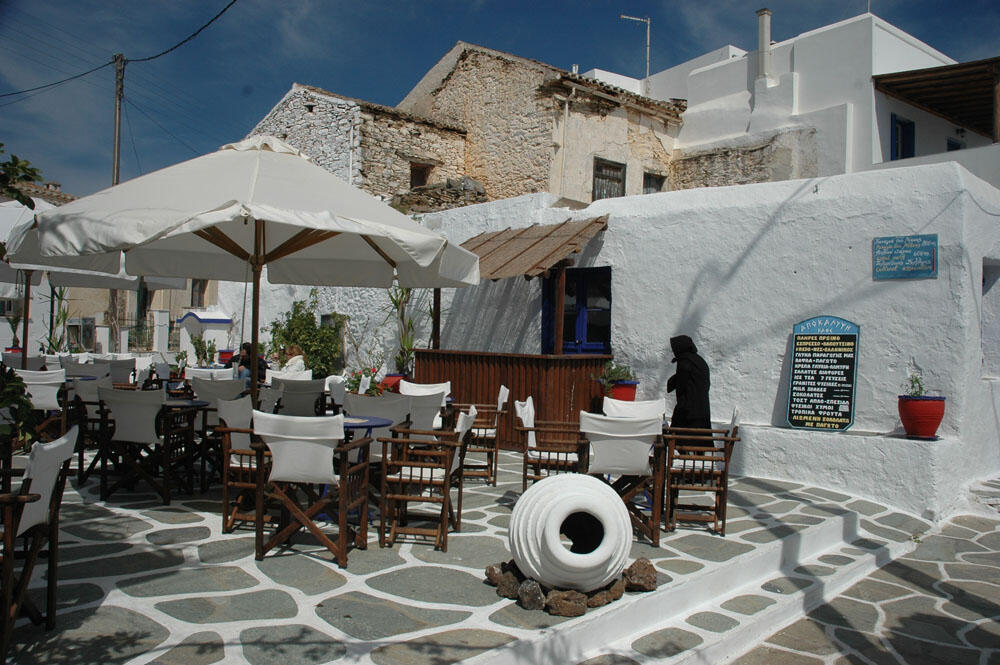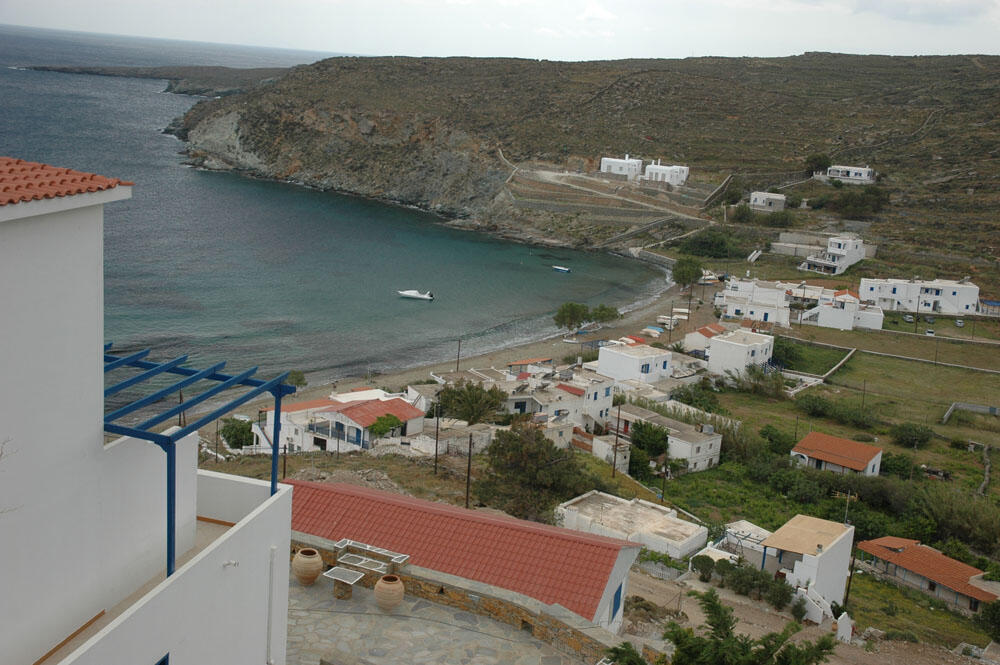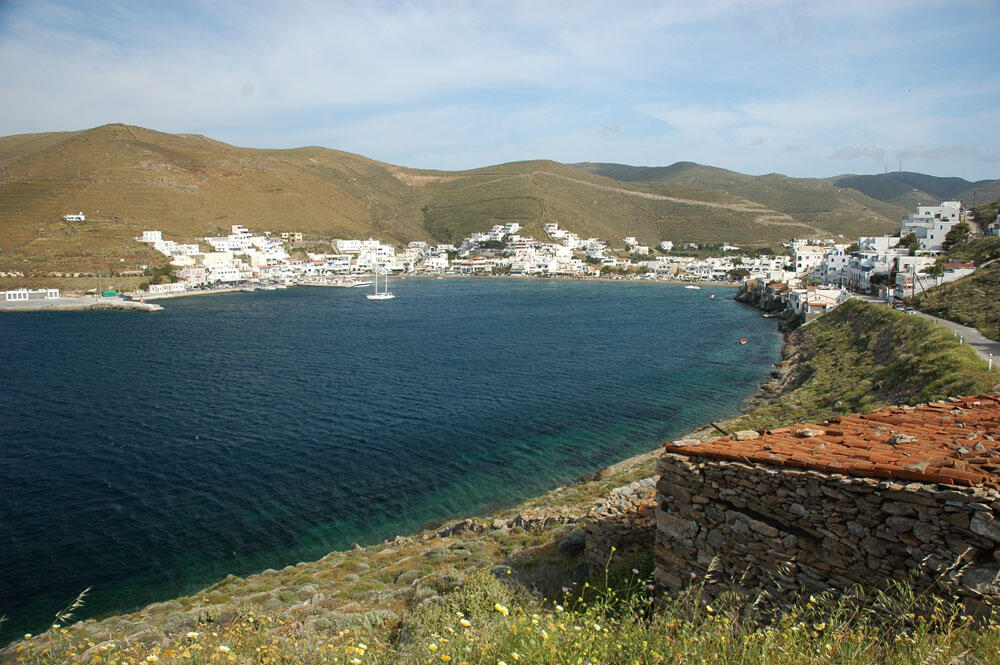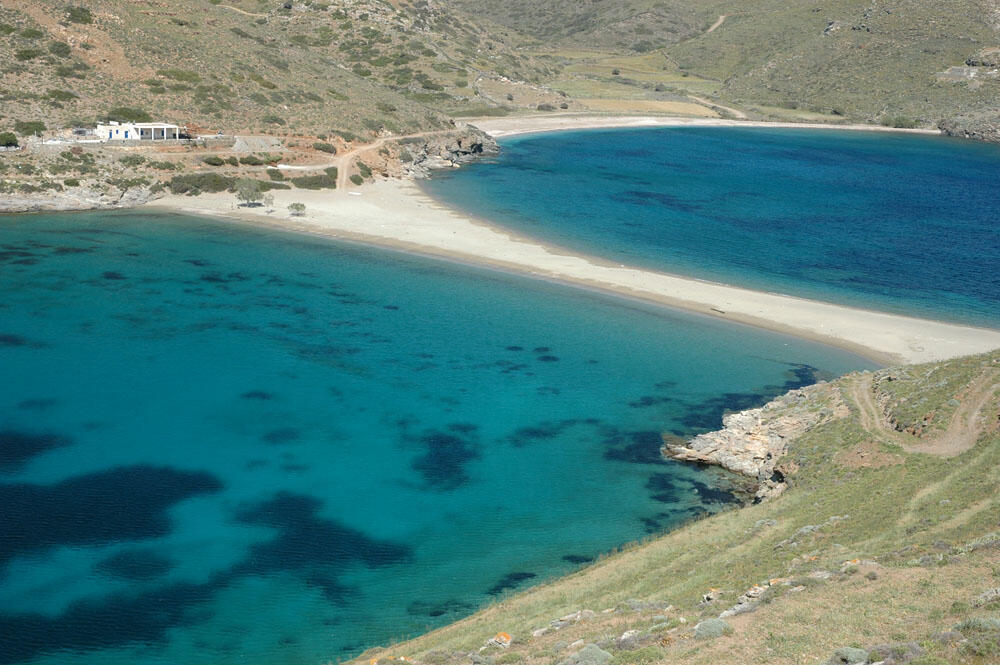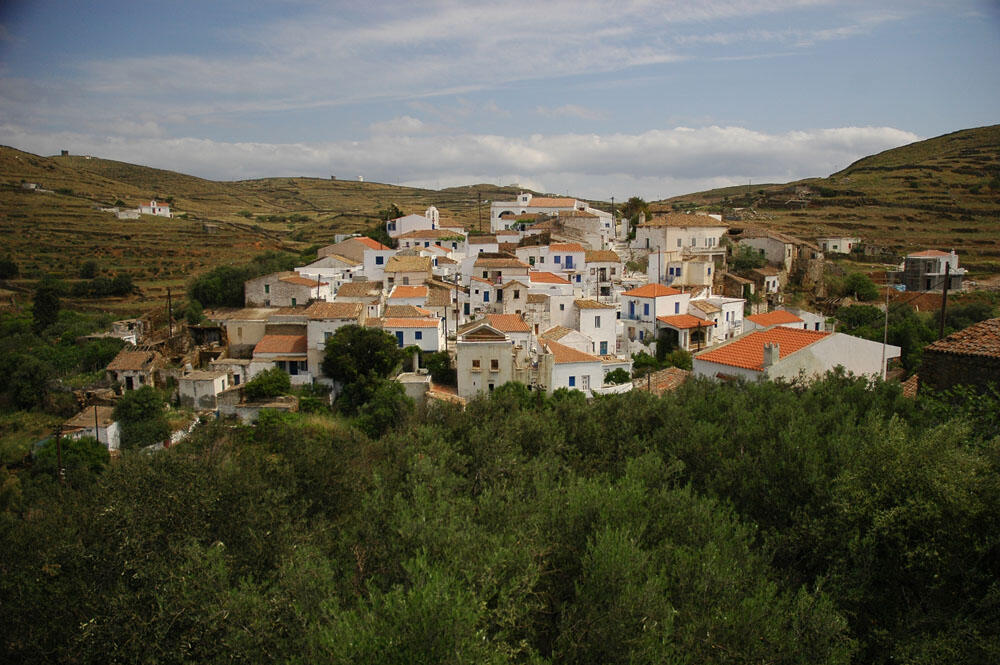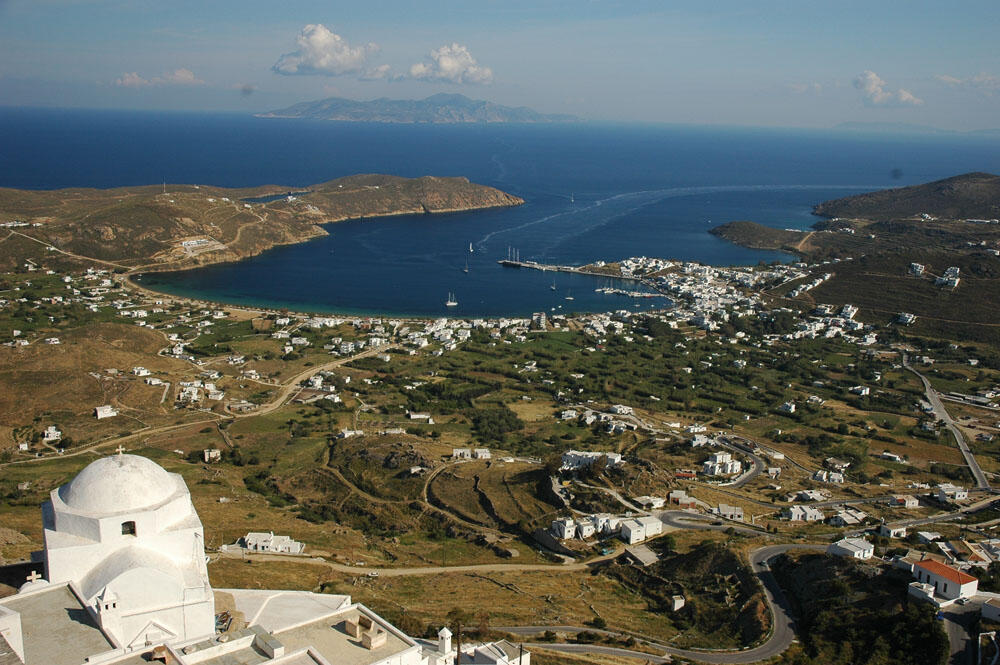
Serifos Island
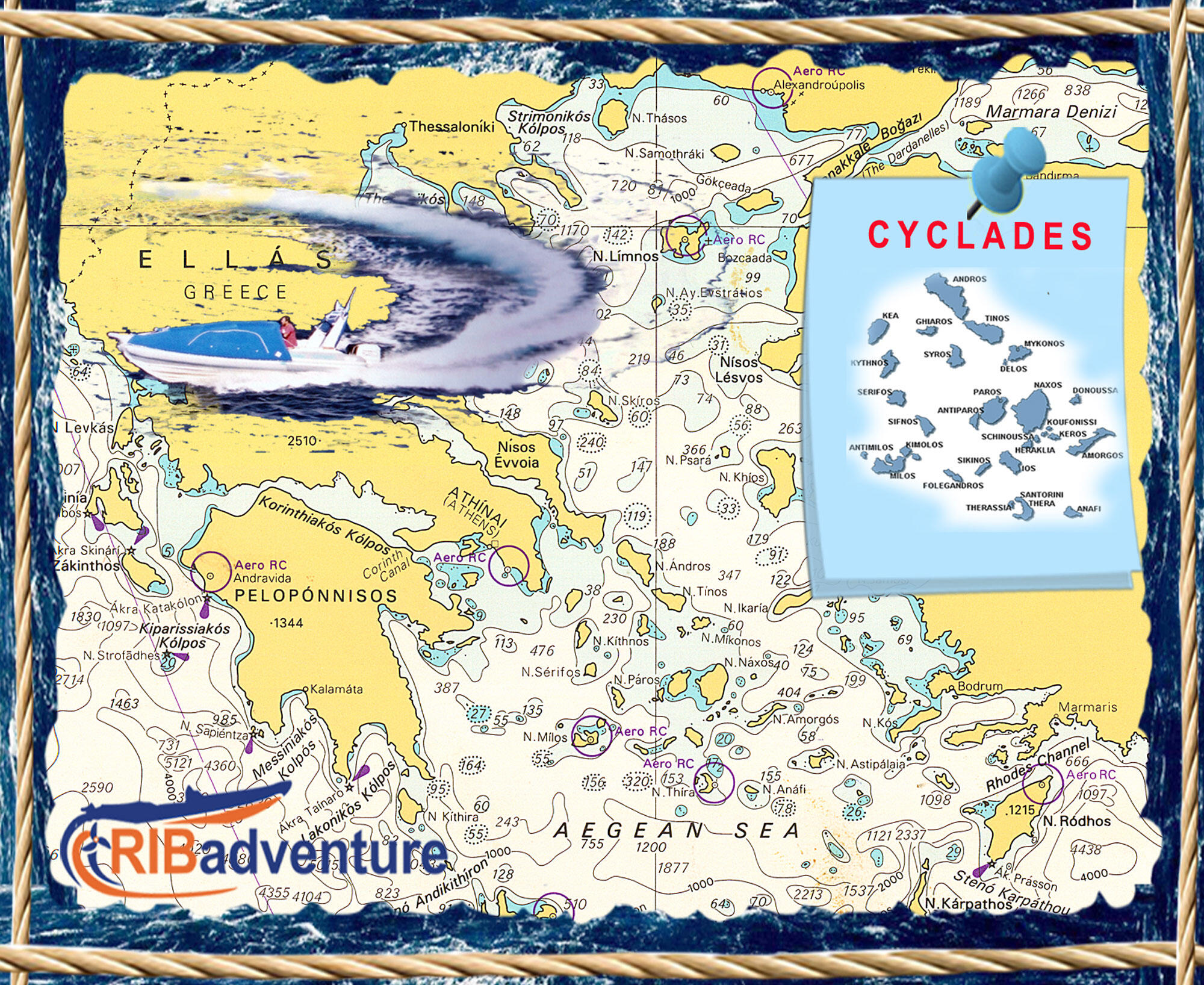
Wandering around Cyclades

Serifos Island

Wandering around Cyclades
Kythnos Island
For many people, the journey is just an escape from the strictly planned daily routines. But beyond that there is something more essential. If we reflect a little deeper, we will see that the impact of everyday life on us is so invisible and so powerful that it really dulls all our senses.
So the journey is precisely this awakening of our senses, which are trapped in a certain and specific context where each of us locks himself, his soul and his mind, inactive to the greatest extent. And of course, traveling your senses in the vastness of the sea, where you can't focus anywhere and nothing obstructs your visual horizon, is like leading them to overflow and finally take off, seducing us into an otherworldly and dreamy world that surpasses our every expectation.
Taking our place behind the console, that invisible euphoria flooded us again.
A few miles later, we would be alone in the vast blue. A small dot in the vastness of the sea. Course, degrees, mark, wind, knots... Magical words, which from now on will permanently grace our lips. The sea will once again become our home. Learn to live on board, travel and dream on board.
This time we had arranged to meet with our group in Loutra of Kythnos, from where our wanderings in the Cyclades began. Without any reason, we decided to directly cover the 160 nautical miles that separated us from Halkidiki, without making any stops. So simple, because we are particularly moved by long journeys.
As soon as it drew up, I quickly removed the sleeping tents and sat on the bow greedily sipping a few hearty sips of my morning coffee, enjoying the gentle rocking of the inflatable in our safe haven. I turned the key and let the engine idle as I wiped the morning moisture off the instruments. With an indescribable joy, as if it were the first time I would travel, I slowly entered my planned rotation. Now, I can say with confidence that this day is the most beautiful of the whole year. I was leaving everything behind and the vast blue flooded every corner of my mind, leaving no space for any other thought. I locked the throttle at 22 knots and the inflatable glided gently in the calm sea. Not even for refueling was I in the mood to stop. I wanted to be constantly floating and enjoy the journey with all my senses, which my low speed allowed me to do. On long journeys, the first thing you get rid of very quickly is the anticipation of arriving at your destination. Without having anything to look forward to immediately, since you will be traveling for many, many hours, the journey takes you completely in its arms. The word "time" was no longer familiar to me, and the only reason I looked at my watch every hour was to mark my position on the nautical chart. It's something I get used to on long trips and of course not only for safety reasons. Really, it's a process I enjoy, nicely filling my travel hours. After all, once again I had decided to renounce the convenience of satellite navigation and immerse myself completely in the magic of travel. So all alone, with the compass and the folded nautical chart that I had attached to the windshield of my console, I set out to sea.
We traveled for several hours along with the sea to the south, until we arrived just before the strait of Andros. The waves now seemed to converge from everywhere, creating a strange sea that did not allow us to relax even for a moment. Constantly turning our bow, trying to find the easiest passages between the choppy waves, we slowly made our way patiently waiting to get out of the strait, knowing that from there on things would get better again. We spent a full hour crossing the strait, at the exit of which the sea again began to soften, allowing us to regain our lost speed. We estimated that we would reach our destination in about an hour, finally closing in on a full eight hours of continuous sailing.
Based in Loutra
In the early afternoon we entered the port of Loutra, located in the north-eastern part of Kythnos. Of course, there was no free space anywhere, since at this time the small port is flooded with tourist boats, which are often tied in double and triple rows.
We dropped by the boat of our old friend Captain Nikolas and despite our tiredness we went out for a tonic coffee. After all, everything is spread out around the harbor, just a few meters away. Cafes, bars and tavernas in a row, which put out their tables on the sandy beach under the shade of the big salt trees, recommending a very picturesque and lively place.
Although Loutra is a small settlement, the first impression you get when looking at it from the sea is that you are in some cosmopolitan Aegean resort, since for many years it has been a busy destination that gathers a lot of people in the summer months.
Beautiful Cycladic houses built on the edges of the low hills, surround the mouth of the bay, which hosts the homonymous sandy beach of the settlement. At the southern end of the beach, you can enjoy the warm and beneficial waters of the thermal spring that reach the sea through a narrow channel.
Loutra is one of the main coastal settlements of Kythnos, together with Merichas which is the main port of the island and the settlement of Panagia tis Kanala. It is without a doubt the most developed part of the island without, however, having altered the authenticity of the place and its people. Famous, since ancient times, for the healing properties of their thermal springs, to which both the name of the settlement and the entire island is due. Thermia, Kythnos is otherwise known, because of the thermal springs of the Baths, which are also the only ones in the Cyclades.
Another main reason that makes Loutra a strategic point, for all of us for whom holidays and boats are synonymous, is that their small marina can be used as a base from which to start our wanderings around the island. At close distances from Loutra are some of the most beautiful sights of Kythnos.
A breath away from Loutra, in essentially the same cove, is the tiny settlement of Agia Irini. Nestled on the west side of the bay of the same name, with the few two-story white houses built at sea level, from which it is separated by a narrow concrete street, which at the same time is also the quay where we can moor. At the end of the waterfront, where the beach of Agia Irini begins, is the wonderful tavern of Souma with the tables next to the sea, which promises us dreamy moments.
Within a radius of one nautical mile, north of the port of Loutra, are the remarkable beaches of Schinari, Maroulas, Kavourocheri, Tria Potamia and Agios Sostis.
At a very short distance and northwest of Loutra, between two hills, is the medieval capital of Kythnos, Kefalokastro or Oria Castle. It is really worth visiting the rock on which the old capital was built, a natural fortress in the wild and imposing Cycladic landscape. Now, only the piles of stones remain there, to remind us that a few hundred people lived on this rock, well protected from the moods of would-be conquerors. In better condition, two of the hundred churches that existed inside the Castle are preserved, Panagia tis Eleusa and Agia Triada.
In the unique mainland
Just five kilometers south of Loutra, lies the amazing Kythnos Country.
Without being famous, since we will rarely hear anything about it and even more rarely we will find it appearing as a travel destination, it is without a doubt one of the most beautiful countries of the Cyclades. A country that would be the envy of every Cycladic island.
With the strong lines of the Cycladic architecture, with a multitude of narrow alleys that start from the central cobbled street towards the neighborhoods of the whitewashed settlement, with the characteristic low arcades and colorful flowers adorning the steps and the small whitewashed courtyards. Everything is neat and clean, tasteful and simple, without exaggerations and outbursts of sensationalism, emitting the passion and love of the few residents for their place, but also the Cycladic beauty in all its glory.
Following the central cobbled street, from the beginning we are still greeted by the genuine Cycladic aura that floods our senses. White houses with blue windows, small cafes in a row with their tables on the cobblestones, beautiful shops, taverns in small squares, flowers and colors that emphasize even more the white and blue of the cube-shaped houses.
Within a few minutes we reach the central square, Messaria as the locals call the Chora, which is the epitome of aesthetics and the unique beauty of the Cyclades. A coffee is essential here too. More to admire and enjoy the harmony and simple grandeur of Messaria. Let us also become, even for a while, a part of this masterpiece painting.
Wandering through the narrow streets of Chora is an amazing experience, with very beautiful images popping up in front of us at every corner, simple and enchanting, without having faded at all over the years.
If you happen to be in Chora during the Easter days, don't miss the "Kunia" custom.
For about ten years now, every year a huge wooden swing has been set up at the beginning of the central cobbled street of Chora, next to the church of Panagia tou Kastro. A man and a woman, dressed in traditional costumes, pretend to be the couple in love that the best man undertakes to "rock" them. Just like it used to be done in the old years, when the couple in love decided to share and somehow make their relationship official. Then go to the "swing", where the groom-to-be took it upon himself to rock the couple hard so that they could be seen from as far away as possible, with the aim of letting the whole village know about their love. This event was also a kind of official marriage proposal to the woman.
Crossing the Deep Channel, which is four nautical miles from Loutra, the south-east side of the island begins, which extends for a distance of eight nautical miles to the southern beacon, where innumerable bays unfold in a row, which in fact are very well sheltered from the meltemias .
First of all, we come across the large bay of Ai Giannis, in which there are five separate beaches that offer great protection from the gales, even when they exceed seven Beaufort. The only thing we have to deal with are the very strong rivulets that rush down from the slopes, that's why we have to moor very close to the shores with even double anchors from certain points.
Immediately after the bay of Agios Ioannis is the long, narrow and safe bay of Agios Stefanos, with a beautiful stretch of beach at its edge and a small tavern on the sand that undertakes to satisfy the visitors.
Panagia Kanala
Passing successive bays, in which beautiful coasts are located, we arrive approximately in the middle of the southeast side, where on the hump of a small peninsula dominates the small settlement of Panagia tis Kanala, one of the most picturesque and beautiful spots of Kythnos. A place of pilgrimage for the locals, since Panagia Kanala is the patron saint of the island. According to tradition, the icon of the Virgin Mary was found in the "channel" of Kythnos Serifos by two fishermen who were raising their fishing lines. It is a very quiet place, with the houses hugging the small pine forest, which is also the only one on the island.
We climbed the small triangular cove and slowly entered the sheltered bay of the settlement. At its tip is Megali Ammos, with shallow green waters and a series of white houses that circle the beautiful beach. We tied up at the small jetty located on the right side of the bay and climbed the steps that led us through the pine trees to the church of Panagia tis Kanala. Continuing a few meters further, we came out on the large stone-paved square with a wonderful view towards the bay and the mountain massif of Serifos clearly visible in the south. Two small taverns with traditional cuisine, set their tables in the square, under the shade of the trees, in a truly idyllic landscape.
From Kanala to the southern lighthouse of Kythnos, many and deserted beaches are formed, with prominent ones being the coast of Skylos, Gaidouromantra and Petroussa.
Based on Mericha
Merichas is the main port of Kythnos and is located approximately in the middle of the western side of the island. Inside the deep natural bay, at the mouth of which is a large, flat sandy beach with clear waters, which is indeed crowded. On the northern side of the bay, there is the wharf where the liners catch and a small jetty behind which the local fishing boats are sheltered. Without being the place that will impress at first glance, it is the center of Kythnos.
The heart of the island beats here. With a lot of tourist traffic, shops, taverns, rooms for rent and hotels scattered among the all-white houses of the settlement, which stretches around the large bay.
It is really worth going up to Akrotiri, as the cove on the southern side of the bay is called, where the coffee bar of the same name is located. In a beautiful environment we will enjoy the enchanting sunset and the view of the endless blue.
But what is clearly missing from Mericha is a marina or even a small area that is capable of accommodating pleasure boats. But we can use the port as a base for food and fuel supplies and spend the night in one of the many leeward bays on the western side of the island.
Immediately above Mericha are some of the most beautiful beaches of the island. First we come across the coves of Episkopi and Apokrusis, which are separated from each other by the small peninsula of Vryokastro, where important archaeological finds were found that date back to between the 7th and 5th BC. century. Both bays are home to long and wide sandy beaches, with many tamarisk trees that ensure the necessary coolness. On the south side of the beach of Episkopi, there is a small quay, where we can comfortably tie up and enjoy our coffee at the cafe "Poundaki" located right above.
In the famous Colonna
Opposite Apokrusis beach is Kolona, the most famous twin sandy beach of Kythnos, which has been the biggest attraction of the island for many years. It certainly occupies a place among the most beautiful and impressive beaches of the entire Aegean, where many boats anchor daily, many of which even spend the night there, since Kolona provides great protection from the meltemias.
A "pillar" of sand connects the islet of Agios Loukas to the mainland, forming a double beach. Its western side is called Colona and its eastern side is called Fykiada. The side of Kolona is the most beautiful with green enchanting waters, but also the one with the best waves, since on the side of Fykiada the strong rip currents often create a rather annoying short wave.
The beautiful coasts, however, do not stop here.
To the south of Mericha, many bays unfold where very remarkable sandy beaches are located. Dirt roads lead to many of them, but there are also several small deserted beaches that offer the necessary quiet and peaceful moments of rest. Between Flabouria beach, where the church of Panagia Flabouriani dominates on the small kavo, and Mavrianos beach, there are two very good small sandy beaches that can only be reached by boat. But even lower down, just before the bay of Agios Dimitrios, we will find wonderful little sandy beaches that promise us endless hours of carefree and relaxation.
Arriving at the southernmost bay of the island, we come across the coastal settlement of Agios Dimitrios, with very beautiful traditional houses perched on the slope of the northern side, while next to the sandy beach there are tavernas with delicious local delicacies. Remarkable are the white little lilies that grow on the sand in August, offering a unique and quite rare sight.
In Driopida
At a distance of five kilometers from Merichas is Dryopida, the second Mediterranean village after Chora and the old capital of Kythnos. Built in a "pit", invisible and protected by the surrounding hills, it is a very beautiful village with important attractions, which gathers a lot of people. Noteworthy are the two-story houses of the settlement with red tiled roofs, which are in complete contrast to the traditional Cycladic architecture.
Stone-paved alleys, small squares, beautiful shops and taverns adorn Dryopida, which is undoubtedly one of the most beautiful villages of Kythnos. In the district of Galata, located directly opposite the central square, we will admire the very old houses and the church of Agios Minas with its unique wood-carved iconostasis. At the edge of the village we will find the Katafiki cave, richly decorated with stalactites and stalagmites, which is used more and more every year.
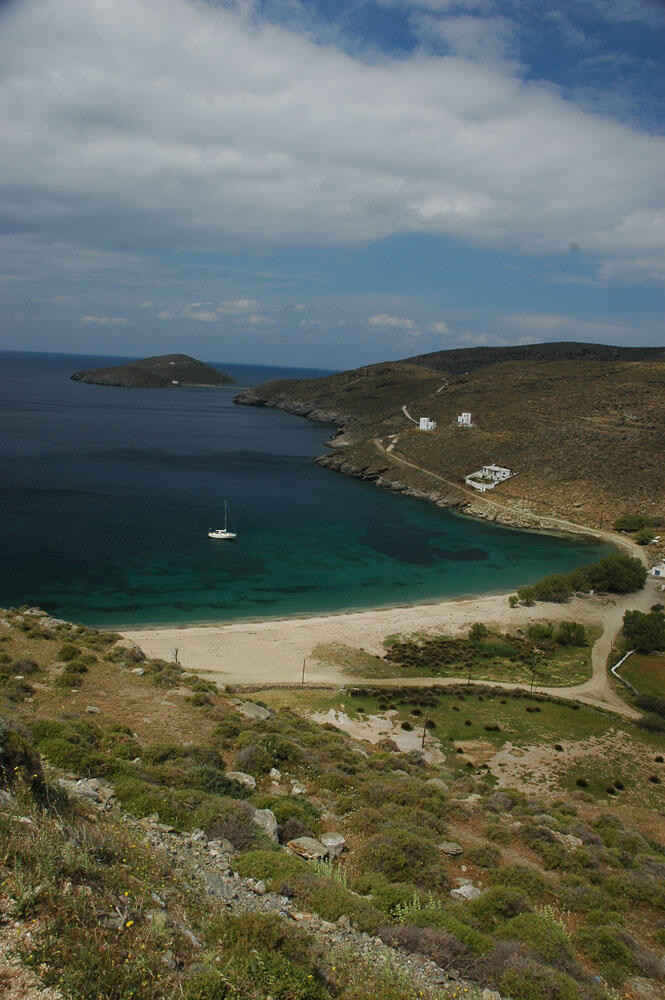
For those who travel
The perimeter of Kythnos reaches 36 nautical miles, with a strongly laced coastline that forms many bays, within which stretch very beautiful sandy beaches, most of which are in fact very well protected from meltemias. With outstanding points the unique Kolona and an amazing Chora, but also many more unexplored corners, it is undoubtedly a very beautiful destination.
As a starting point, Loutra is clearly preferable to Merichas because it is more picturesque, has a small marina that is completely safe, while refueling is very easy, with a van that has a meter and comes in a few minutes from the gas station of the nearby Chora. The only drawback is that when the meltemias blow with a force of more than 6 Beaufort, we will have to travel a few miles to Kefalos or to Vathy Avlaki in rough weather to visit the beaches on the west or east side of the island.
As far as overnight bays are concerned, both sides of Kythnos have many spots that are very well protected from meltemias. However, you need to be careful with the craters, which often come down with terrifying force.
If you want to spend the night in the bay of Ai Giannis on the eastern side of Kythnos, prefer the Vasiliko cove, which is the southernmost of the eastern side of the bay. It is the main cove of the bay of Ai Giannis, where the waves do not blow. If you want to spend the night in Canala bay, you should know that the bottom is covered with large seaweeds that do not let the anchor sit down, causing it to drag out.
If you still want to spend the night on the west side of the island, prefer to anchor in the cove located a few meters before the sandy beach of the enchanting Kolona.
Dangerous spots:
- the land of the "cow" located between the bay of Ai Giannis and the bay of Agios Stefanos, marked B 37o23:48΄A 24o27:92΄
- the dry land of Kanala, located a few dozen meters from the cape of the small peninsula on which the settlement of Panagia tis Kanala is built.
Local times
The meltemi lasts for about 40 days, from July 10 to August 20. It begins with the breaking of the sun directly as a tramuntana and when it is to cut, it goes to the grego at two o'clock in the afternoon and then it breaks. Usually this is the daily course of the melt, with the morning starting fresh and the afternoon breaking. In other words, the wind stops and only the ripples remain.
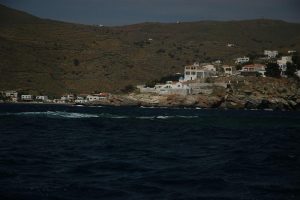
It is characteristic that in the wider area of Kythnos, we observe different weather from time to time. In other words, if the wind blows, we will find sea in the bay of Tzias Makronissos. However, if it is windy, we will find sea in the bay of Tzias Kythnos, while at the same time in the bay of Tzias Makronissos the weather will be good. So don't be fooled if crossing the strait of Makronissou Tzia has a good sea. After Tamelo, the shepherd can lurk.
Tzias Kythnos bugazi is certainly one of the most difficult passages, but there are ways to cross it more painlessly when the meltemias blow, which usually exceed 5 Beaufort in the summer months.
When, therefore, we are heading from Sounio for Syros or Paros, and the weather reaches above 5 Beaufort, it is preferable, immediately after Tamelos of Tsia, to keep close to its eastern shores, and to sail high for several miles, so that we may be able to in retrospect to put the weather aside and continue our journey.
Horsing near the eastern shores of Tzia is more passable, while if we head directly for Kefalos of Kythnos, where the bogazi from its middle and beyond usually produces "snakes", our discomfort is assured.
We have to follow roughly the same course on our way back. In other words, returning from Paros or Naxos with destination Sounio, we should keep close to the southern coasts of Syros in the direction of Gyaros and then mark approximately the middle of the eastern coasts of Tzia, in order to then easily descend towards Tamelos.
The exact same applies when we start from Sounio or Lavrio with destination Loutra of Kythnos. Crossing Tamelos, we change our course and travel parallel and very close to the eastern shores of Tzia. After we get high enough and have avoided the middle of the Tzias Kythnos bay, we can even go astern if there is a thick sea. Of course we travel a few extra miles, but we are rewarded with a better and faster journey, and with clearly much less strain on the boat and crew.
In conclusion, our aim should be to pass through Kefalos as openly as possible. We have to pass through the sea area between Katakolo and Vathy Avlaki, to the north-east of Kythnos, in the same open way. When the wind blows in this area, it raises a very large wave due to currents and anti-mamals mainly, and produces very thick seas. In the area of Loutra and Livadaki, due to the large bays, the sea "digests", something that cannot be done any further since the steep coasts create large headwaters and very high waves.
But where is the uniqueness of Tzias Kythnos's bougazi hidden?
A careful look at the nautical chart of the area is enough to draw very useful conclusions. The secret of the bougazi, therefore, lies in its bottom.
It is a "bench" with a depth of 100 to 150 meters, starting from the eastern shores of Tzia and reaching the northwestern shores of Kythnos, occupying a distance of approximately 8 nautical miles.
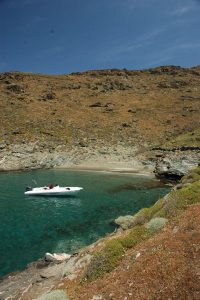
It is characteristic that in the wider area of Kythnos, we observe different weather from time to time. In other words, if the wind blows, we will find sea in the bay of Tzias Makronissos. However, if it is windy, we will find sea in the bay of Tzias Kythnos, while at the same time in the bay of Tzias Makronissos the weather will be good. So don't be fooled if crossing the strait of Makronissou Tzia has a good sea. After Tamelo, the shepherd can lurk. That is why the weather is longer in the middle of the bay and towards Kythnos, because that is exactly where the "gutter" is located.
Inside this "gutter", the currents are very strong and reach 7 knots. That is, imagine a torrent running at high speed through a narrow and abyssal corridor. This torrent, of course, affects both the intensity of the wave and its height. So don't be surprised if after Tamelos the weather is 5 to 6 Beaufort and from the middle of the bay and as we approach Kythnos it becomes local seven with very strong waves.
...keep Ribbing!

